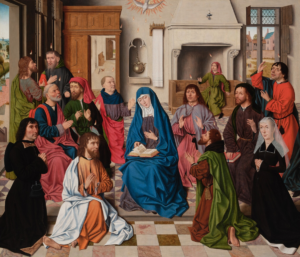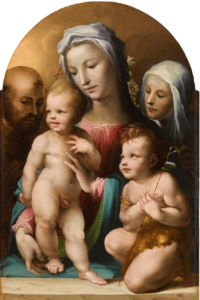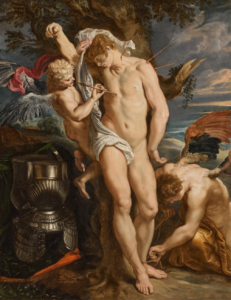
Pentecost by the Master of the Baroncelli Portraits
Last week, the Christie’s, Sotheby’s, and Bonhams London salerooms hosted a series of Old Masters sales across three days. One of the more memorable sales occurred on Wednesday, July 5, when Sotheby’s hosted an Old Masters and Nineteenth-Century paintings sale in the evening. The forty-nine available lots ranged from fifteenth-century religious icons, Dutch still-lifes, Tudor-era English portraits, and a few nineteenth-century landscapes for good measure (w/p = with buyer’s premium). All three of the most valuable pieces came early in the sale, within the first eleven lots. At the very top was a religious oil on panel painting created around 1490 in what is now Belgium. The subject is a scene from the New Testament, showing Christ’s disciples celebrating Pentecost when the Holy Spirit descended upon them, represented by the flaming dove above them. Despite the biblical story, the apostles gather in a room that would look more familiar in fifteenth-century Belgium than in ancient Judea. The creator of the painting is unknown, but art historians have identified works of a similar style, leading them to give this anonymous artist the nickname Master of the Baroncelli Portraits. Sotheby's specialists traced the work's provenance back to around 1600 when it first entered the Rapaert family collection; they owned the painting until 1931. It last sold at Christie’s London in 2010 for £3.7M (or about £5.4M / $6.9M today), and this time, Pentecost hit its low estimate at £7M / $8.9M (or £7.9M / $10M w/p).

Virgin and Child by Domenico Beccafumi
The two remaining top lots both ended up selling for £4.2M / $5.3M (or £5.1M / $6.5M w/p). The first was the oil on panel painting Virgin and Child with the infant St. John the Baptist, St. Francis, and St. Catherine of Siena by the Italian Mannerist Domenico Beccafumi. The last time this painting saw the inside of an auction house was in 1928, when it sold as part of an estate sale at Berlin’s Kunst-Auctions-Haus. Back then, it sold for 3,500 Reichsmarks, equivalent to $14,785 today. The work was estimated to sell between £3M and £4M, putting its final hammer price slightly above the maximum estimate. Meanwhile, selling for the same hammer price was Saint Sebastian tended by two angels by Peter Paul Rubens. The painting shows the titular saint when he was shot full of arrows during his martyrdom. The work has an extensive provenance, having been in the same aristocratic Italian family collection between 1600 and 1733, before making its way to, of all places, St. Louis, Missouri. The Rubens graced the block of the St. Louis auction house Ivey-Selkirk more than once, where the now-former owner acquired it in 2008. Since 2010, it has been on loan to the Rubenshuis in Antwerp, the museum containing Rubens’s house and workshop. However, it is unknown if the new owner will continue this loan. The former owner, who bought it in St. Louis, made a good chunk of change from the sale since he purchased the work for only $32K due to it being misattributed to Rubens’s French contemporary Laurent de La Hyre. Saint Sebastian was given an estimate range of £4M to £6M, with the hammer falling just above the minimum.

Saint Sebastian tended by two angels by Peter Paul Rubens
The sale also included several surprises, the most noteworthy of which was a portrait of Queen Katherine Parr, the sixth and final wife of King Henry VIII of England. The portrait was likely created around 1548, shortly after the king's death. It is one of only two surviving contemporary portraits of the queen, and both are attributed to an English portraitist known only as Master John. However, the artist's identity is a relatively recent discovery. The portrait was sold at auction five times over the past two hundred years. The records from those sales indicate that specialists have not always attributed the work to Master John, and that they did not always identify the portrait's subject as Katherine Parr. When it sold at auction in 1829, 1831, and 1841, the work was described as a portrait of Queen Mary I attributed to the Flemish painter Lucas de Heere. Previously, in 1827, Christie’s attributed the work to the portraitist Antonis Mor, while later, in 1848, they described it as being by Hans Holbein. It wasn’t until 1996 that Susan James finally identified the subject as Katherine Parr after looking at the queen‘s jewelry. On the front of her dress is a brooch featuring a crown on top and three pearls hanging from the bottom. This matches the appearance of the Coronet Brooch, known to have been part of Katherine Parr’s jewelry collection and featured in Master John’s other portrait of the queen now on display at the National Portrait Gallery in London. The portrait was probably the day's biggest surprise, with bidding extending far longer than anticipated. Expected to sell for between £600K and £800K, the portrait of Katherine Parr eventually sold for £2.8M / $3.5M (or £3.4M / $4.3m w/p), or three-and-a-half times the high estimate.
Of the forty-nine available, fifteen sold within their estimates, giving Sotheby’s specialists a 31% accuracy rate. Another nine lots (18%) sold below estimate, while eight (16%) sold above. Unfortunately, seventeen lots (35%) did not meet their reserves and went unsold, including the highly-valued seascape A Calm Sea by the Dutch Golden Age painter Jan van de Cappelle, estimated to sell for between £800K and £1.2M. The sheer number of unsold lots caused the sale to make slightly less than expected, bringing in £32.7M / $41.5M against a total pre-sale estimate of £34.8M to £49.4M.
Sotheby’s Old Masters & 19th Century Paintings
Pentecost by the Master of the Baroncelli Portraits
Last week, the Christie’s, Sotheby’s, and Bonhams London salerooms hosted a series of Old Masters sales across three days. One of the more memorable sales occurred on Wednesday, July 5, when Sotheby’s hosted an Old Masters and Nineteenth-Century paintings sale in the evening. The forty-nine available lots ranged from fifteenth-century religious icons, Dutch still-lifes, Tudor-era English portraits, and a few nineteenth-century landscapes for good measure (w/p = with buyer’s premium). All three of the most valuable pieces came early in the sale, within the first eleven lots. At the very top was a religious oil on panel painting created around 1490 in what is now Belgium. The subject is a scene from the New Testament, showing Christ’s disciples celebrating Pentecost when the Holy Spirit descended upon them, represented by the flaming dove above them. Despite the biblical story, the apostles gather in a room that would look more familiar in fifteenth-century Belgium than in ancient Judea. The creator of the painting is unknown, but art historians have identified works of a similar style, leading them to give this anonymous artist the nickname Master of the Baroncelli Portraits. Sotheby's specialists traced the work's provenance back to around 1600 when it first entered the Rapaert family collection; they owned the painting until 1931. It last sold at Christie’s London in 2010 for £3.7M (or about £5.4M / $6.9M today), and this time, Pentecost hit its low estimate at £7M / $8.9M (or £7.9M / $10M w/p).
Virgin and Child by Domenico Beccafumi
The two remaining top lots both ended up selling for £4.2M / $5.3M (or £5.1M / $6.5M w/p). The first was the oil on panel painting Virgin and Child with the infant St. John the Baptist, St. Francis, and St. Catherine of Siena by the Italian Mannerist Domenico Beccafumi. The last time this painting saw the inside of an auction house was in 1928, when it sold as part of an estate sale at Berlin’s Kunst-Auctions-Haus. Back then, it sold for 3,500 Reichsmarks, equivalent to $14,785 today. The work was estimated to sell between £3M and £4M, putting its final hammer price slightly above the maximum estimate. Meanwhile, selling for the same hammer price was Saint Sebastian tended by two angels by Peter Paul Rubens. The painting shows the titular saint when he was shot full of arrows during his martyrdom. The work has an extensive provenance, having been in the same aristocratic Italian family collection between 1600 and 1733, before making its way to, of all places, St. Louis, Missouri. The Rubens graced the block of the St. Louis auction house Ivey-Selkirk more than once, where the now-former owner acquired it in 2008. Since 2010, it has been on loan to the Rubenshuis in Antwerp, the museum containing Rubens’s house and workshop. However, it is unknown if the new owner will continue this loan. The former owner, who bought it in St. Louis, made a good chunk of change from the sale since he purchased the work for only $32K due to it being misattributed to Rubens’s French contemporary Laurent de La Hyre. Saint Sebastian was given an estimate range of £4M to £6M, with the hammer falling just above the minimum.
Saint Sebastian tended by two angels by Peter Paul Rubens
The sale also included several surprises, the most noteworthy of which was a portrait of Queen Katherine Parr, the sixth and final wife of King Henry VIII of England. The portrait was likely created around 1548, shortly after the king's death. It is one of only two surviving contemporary portraits of the queen, and both are attributed to an English portraitist known only as Master John. However, the artist's identity is a relatively recent discovery. The portrait was sold at auction five times over the past two hundred years. The records from those sales indicate that specialists have not always attributed the work to Master John, and that they did not always identify the portrait's subject as Katherine Parr. When it sold at auction in 1829, 1831, and 1841, the work was described as a portrait of Queen Mary I attributed to the Flemish painter Lucas de Heere. Previously, in 1827, Christie’s attributed the work to the portraitist Antonis Mor, while later, in 1848, they described it as being by Hans Holbein. It wasn’t until 1996 that Susan James finally identified the subject as Katherine Parr after looking at the queen‘s jewelry. On the front of her dress is a brooch featuring a crown on top and three pearls hanging from the bottom. This matches the appearance of the Coronet Brooch, known to have been part of Katherine Parr’s jewelry collection and featured in Master John’s other portrait of the queen now on display at the National Portrait Gallery in London. The portrait was probably the day's biggest surprise, with bidding extending far longer than anticipated. Expected to sell for between £600K and £800K, the portrait of Katherine Parr eventually sold for £2.8M / $3.5M (or £3.4M / $4.3m w/p), or three-and-a-half times the high estimate.
Of the forty-nine available, fifteen sold within their estimates, giving Sotheby’s specialists a 31% accuracy rate. Another nine lots (18%) sold below estimate, while eight (16%) sold above. Unfortunately, seventeen lots (35%) did not meet their reserves and went unsold, including the highly-valued seascape A Calm Sea by the Dutch Golden Age painter Jan van de Cappelle, estimated to sell for between £800K and £1.2M. The sheer number of unsold lots caused the sale to make slightly less than expected, bringing in £32.7M / $41.5M against a total pre-sale estimate of £34.8M to £49.4M.